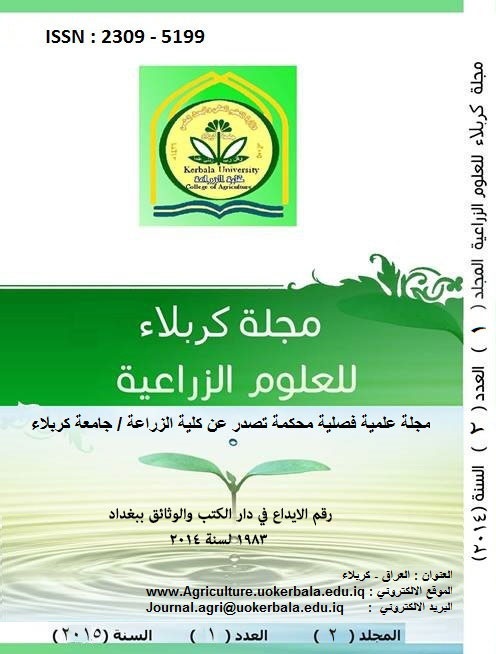Comparing the effect of bio and organic fertilizers on some growth factors and yield of broad bean
DOI:
https://doi.org/10.59658/jkas.v3i1.535Abstract
Field experiment was conducted in Hatamia / Balad ( 2014 ) using C.R.D design with three treatment to investigate and comparing the effect of biofertiizer of Rhizobium leguminosarum and organic manure (sheep res) with the recommended chemical fertilization on some growth factors and yield of broad bean. Results showed that significant differences among organic residues and biofertiizer with the reommanded chemical fertilizer for all studied parameters. Treatment of biofertiizers was the best on plant height 50.4 cm , number of branches 13.6/ pant , dry weight 16.98 gm , chlorophyll content 54.1mg.g-1 , protein percentage 26.39%, weight of 100 grains 195.46 gm , and total yield 1848.41 kg.ha-1 compared with reommanded chemical fertilizer addition , that gave lowest means in the studied parameters respectely ( 41.7 cm, 10.2 /plant, 11.97 gm, 51.6 mg.g-1, 24.13% , 162.27 gm, and 1684.93 kg.ha-1 ). This studying showed that we can use Bacteria Rhizobium leguminosarum as a biofertilizer with broad bean to improve growth an productivity.it can be retained 60 – 70 % from nitrogen fertilizer.
Downloads
Published
How to Cite
Issue
Section
License
Copyright (c) 2016 Copyright (c) 2024 is the Author's article. Published by the Journal of Kerbala for Agricultural Sciences under a CC BY 4.0 license

This work is licensed under a Creative Commons Attribution 4.0 International License.
Licensing Terms
All articles are published under a Creative Commons License and will be directed to the Creative Commons Attribution 4.0 International License (CC BY 4.0) That permits use, distribution, and reproduction in any medium, provided the original work is properly cited. This license also allows the work to be used for commercial purposes.
Use by both non-commercial and commercial users
This content is licensed under a Creative Commons Attribution 4.0 International (CC BY 4.0) license, permitting use by both non-commercial and commercial users. Individual users may access, download, copy, display, and redistribute the articles to colleagues, as well as adapt, translate, and text- and data-mine the content, subject to the following conditions:
- The author's moral rights, including the right of attribution and the right to protect their work from derogatory treatment, are respected.
- Where content in the article is identified as belonging to a third party, users must ensure that any reuse complies with the copyright policies of the owner of that content.
- If the article content is reused for research or educational purposes, users should maintain a link to the appropriate bibliographic citation, including the DOI and a link to the published version on the journal's website.

